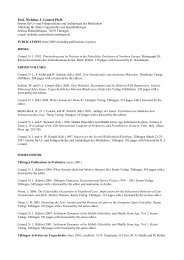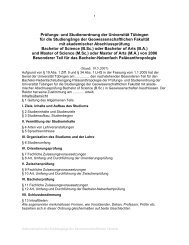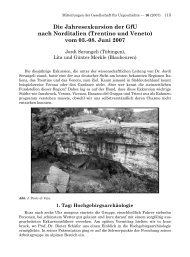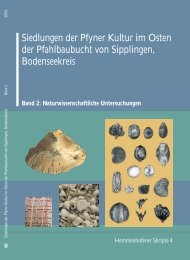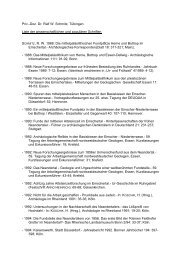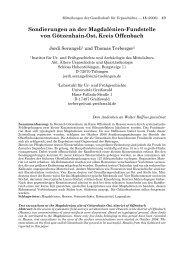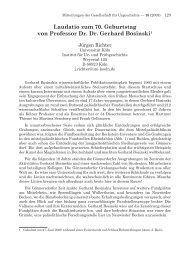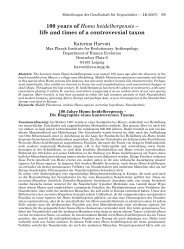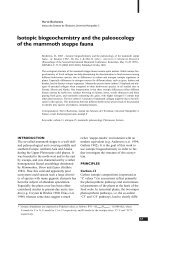bronze age environment and economy in the troad - Universität ...
bronze age environment and economy in the troad - Universität ...
bronze age environment and economy in the troad - Universität ...
Create successful ePaper yourself
Turn your PDF publications into a flip-book with our unique Google optimized e-Paper software.
chapter 3: analysis<br />
exception of <strong>the</strong> sample from <strong>the</strong> context older than Troy I<br />
(Graph 17, 19a, 19b).<br />
Correspond<strong>in</strong>gly, <strong>the</strong> percent<strong>age</strong> participation of members of<br />
<strong>the</strong> waterplant group (Graph 18 <strong>and</strong> 19d) is relatively low,<br />
except for samples conta<strong>in</strong><strong>in</strong>g Chara sp. associated with <strong>the</strong><br />
cereal rema<strong>in</strong>s. Samples conta<strong>in</strong><strong>in</strong>g ‛horticultural’ rema<strong>in</strong>s<br />
(olive, grape <strong>and</strong> fig) conta<strong>in</strong> very few rema<strong>in</strong>s of waterplants,<br />
<strong>and</strong> <strong>the</strong> same is true of <strong>the</strong> sample from <strong>the</strong> context older than<br />
Troy I.<br />
The percent<strong>age</strong> of plant rema<strong>in</strong>s <strong>in</strong> each sample belong<strong>in</strong>g to<br />
<strong>the</strong> weed group (Graph 20 <strong>and</strong> 19c) is relatively low, with<br />
values between 10% <strong>and</strong> 20%.<br />
3.2.3.3 Diversity<br />
Look<strong>in</strong>g at <strong>the</strong> species spectra with<strong>in</strong> <strong>the</strong> three classes of<br />
species (crops, weeds, waterplants), a relatively high variability<br />
<strong>in</strong> occurrences (presence) is recognisable (Graph 21). The bulk<br />
of <strong>the</strong> samples have between four <strong>and</strong> eight different crop<br />
categories. The waterplants are very variably represented.<br />
What is strik<strong>in</strong>g is <strong>the</strong> large number of weed species <strong>in</strong> <strong>the</strong><br />
sample from <strong>the</strong> context older than Troy I. This broad<br />
spectrum is dom<strong>in</strong>ated <strong>in</strong> terms of abundance by <strong>the</strong> few<br />
species that are not <strong>in</strong>cluded <strong>in</strong> <strong>the</strong> weed group, <strong>the</strong> waterplant<br />
group or <strong>the</strong> crop group, but which were categorised as<br />
rema<strong>in</strong>s deriv<strong>in</strong>g from dung.<br />
Although comparisons of diversity between different sites are<br />
complicated by <strong>the</strong> taphonomic problems mentioned<br />
previously, it has to be noted that <strong>the</strong>re is <strong>the</strong> same number of<br />
crop categories (8) dur<strong>in</strong>g Early Bronze Age Troy as dur<strong>in</strong>g<br />
Kumtepe B, although with some different species.<br />
The range of wild plants is broad, but none of those is<br />
particularly abundant. The above-mentioned sample older than<br />
Troy I has a very low evenness, which is due to <strong>the</strong> abundance<br />
of some species deriv<strong>in</strong>g from open, habitats. In all, <strong>the</strong> weeds<br />
tend to <strong>in</strong>dicate little specialisation, or alternatively that cropprocess<strong>in</strong>g<br />
could have taken place at some distance from <strong>the</strong><br />
settlement.<br />
3.2.4 Middle Bronze Age Troy<br />
3.2.4.1 Associations of species <strong>and</strong> samples<br />
The data set used for statistical analysis consisted of 27<br />
samples <strong>and</strong> 71 species. Except for one (K8BP09), <strong>the</strong> samples<br />
all belong to Troy IV horizons. Some of <strong>the</strong> samples were<br />
almost pure crop deposits, which resulted on <strong>the</strong> whole <strong>in</strong><br />
totally different patterns compared to those from Early Bronze<br />
Age Troy, where <strong>the</strong> bulk of samples consisted of cropprocess<strong>in</strong>g<br />
by-products <strong>and</strong> plant rema<strong>in</strong>s associated with<br />
dung.<br />
The scatter plot of <strong>the</strong> species (Graph 22) shows a clear pattern<br />
created by <strong>the</strong> crop stor<strong>age</strong> samples. The two species which<br />
dom<strong>in</strong>ate variation with<strong>in</strong> this data set are Pisum sativum <strong>and</strong><br />
L<strong>in</strong>um usitatissimum. While pea is restricted to a few samples<br />
of similar composition, flax is frequent <strong>in</strong> various samples of<br />
different species composition. Beside Camel<strong>in</strong>a sativa, <strong>the</strong><br />
species most commonly found with flax is Fumaria offic<strong>in</strong>alis<br />
(Graph 19). In graph 22 <strong>the</strong> first axis separates <strong>the</strong> stor<strong>age</strong><br />
f<strong>in</strong>ds of flax <strong>and</strong> Camel<strong>in</strong>a sativa from all <strong>the</strong> o<strong>the</strong>r rema<strong>in</strong>s,<br />
<strong>in</strong>clud<strong>in</strong>g garden pea, cereals, grape, fig, lentil <strong>and</strong> bitter vetch.<br />
In some samples flax was accompanied <strong>in</strong> a ratio of up to 1:1<br />
by gold-of-pleasure. Most of <strong>the</strong> samples <strong>in</strong> which <strong>the</strong>se crops<br />
occur represent cleaned stored products. Many of <strong>the</strong>m come<br />
from one Middle Bronze Age build<strong>in</strong>g, where <strong>the</strong> crops are<br />
found <strong>in</strong> different areas, probably <strong>in</strong>dicat<strong>in</strong>g <strong>the</strong> spatial<br />
pattern<strong>in</strong>g of activities (Figures 6 <strong>and</strong> 7).<br />
The statistical impact of <strong>the</strong> flax <strong>and</strong> pea samples resulted <strong>in</strong> a<br />
dense concentration of all <strong>the</strong> o<strong>the</strong>r samples <strong>and</strong> species <strong>in</strong> one<br />
part of <strong>the</strong> diagram (second quadrant). The upper part of this<br />
concentration () consists of weeds <strong>and</strong> Quercus sp.. In<br />
square barley gra<strong>in</strong>, fig, grape, bitter vetch <strong>and</strong> various<br />
weeds such as Chenopodium album, Lathyrus sativus/cicera,<br />
<strong>and</strong> moisture-<strong>in</strong>dicat<strong>in</strong>g plants occur. The species<br />
accumulation conta<strong>in</strong>s e<strong>in</strong>korn gra<strong>in</strong>, barley rachises, lentil<br />
<strong>and</strong> a relatively large number of moisture-<strong>in</strong>dicat<strong>in</strong>g plants:<br />
Aeluropus litoralis, Juncus sp., Spergularia mar<strong>in</strong>a, Salsola<br />
kali are more or less salt tolerant <strong>and</strong> seem to be associated<br />
with <strong>the</strong> two types of cereal rema<strong>in</strong>s mentioned, suggest<strong>in</strong>g<br />
ei<strong>the</strong>r cultivation under relatively moist <strong>and</strong> salty conditions or<br />
that rum<strong>in</strong>ants may have been grazed <strong>in</strong> similar <strong>environment</strong>s,<br />
depend<strong>in</strong>g on <strong>the</strong> context of <strong>the</strong> samples. O<strong>the</strong>r waterplants,<br />
possibly not related to crops (e.g. Typha latifolia) also occur <strong>in</strong><br />
this part of <strong>the</strong> diagram. Square <strong>in</strong>cludes most of <strong>the</strong> cereal<br />
gra<strong>in</strong> <strong>and</strong> chaff categories; <strong>the</strong> only wild plants <strong>in</strong> this group<br />
are some waterplants such as Cladium mariscus <strong>and</strong> Chara sp.,<br />
<strong>and</strong> Cistus sp. (a member of maquis-type vegetation).<br />
In order to get a clearer picture of pattern<strong>in</strong>g with<strong>in</strong> <strong>the</strong> data,<br />
<strong>the</strong> two crops, which determ<strong>in</strong>ed <strong>the</strong> patterns described above,<br />
flax <strong>and</strong> garden pea, were elim<strong>in</strong>ated (Graph 22, right). Hulled<br />
wheat chaff is now separated from <strong>the</strong> o<strong>the</strong>r rema<strong>in</strong>s on <strong>the</strong><br />
first axis. The fourth axis separates emmer gra<strong>in</strong> from <strong>the</strong> o<strong>the</strong>r<br />
rema<strong>in</strong>s. As <strong>in</strong> <strong>the</strong> previous diagram, barley clearly has<br />
different associations to <strong>the</strong> o<strong>the</strong>r cereals. The gra<strong>in</strong> lies with<strong>in</strong><br />
a group of Lolium spp., which might <strong>in</strong>dicate that <strong>the</strong><br />
morphological similarities between <strong>the</strong>se seeds make it<br />
difficult to separate <strong>the</strong> weedy grass from <strong>the</strong> crop gra<strong>in</strong>. The<br />
rachises of barley are, as seen earlier, associated with smallseeded<br />
grasses (Aeluropus litoralis, Eragrostis m<strong>in</strong>or), some of<br />
<strong>the</strong>m moisture-<strong>in</strong>dicat<strong>in</strong>g, <strong>and</strong> with Juncus sp.. It is not<br />
possible to decide at this st<strong>age</strong> whe<strong>the</strong>r a crop-process<strong>in</strong>g byproduct<br />
or rema<strong>in</strong>s from animal feed are represented. The<br />
hulled wheat chaff rema<strong>in</strong>s are only associated with a few wild<br />
plants from a variety of habitats, which <strong>in</strong>dicates an<br />
accumulation of plants from various sources. Hulled wheat<br />
gra<strong>in</strong>s are associated with various weeds from drier habitats<br />
than those associated with barley rachises. Fig lies with<strong>in</strong> a<br />
group of Chenopodietea weeds (Chenopodium album,<br />
Polygonum aviculare). Grape is associated with moisture<strong>in</strong>dicat<strong>in</strong>g<br />
plants (Eleocharis uniglumis/palustris, Carex<br />
divulsa), which might well, although <strong>the</strong>y cannot be considered<br />
as weeds, <strong>in</strong>dicate <strong>the</strong> natural habitat on <strong>the</strong> slopes of <strong>the</strong> river<br />
Scam<strong>and</strong>er, possibly browsed by animals whose dung was<br />
used for fuel.<br />
Compar<strong>in</strong>g <strong>the</strong> patterns of <strong>the</strong> scatter plots with those from <strong>the</strong><br />
Early Bronze Age data, <strong>the</strong>re is not such a dist<strong>in</strong>ct separation<br />
of <strong>the</strong> horticultural crops <strong>and</strong> <strong>the</strong> cereals, although <strong>the</strong> Middle<br />
Bronze Age samples were not apparently from more mixed<br />
41





